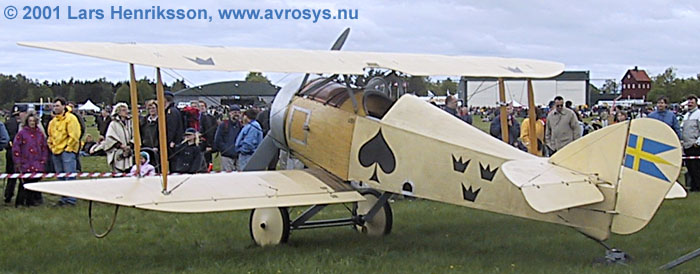|
|
||
|
Ö 1 - FVM/CFM Tummeliten ”Tummelisa” (1926-1935) |
||
|
Page 1 (1) |
||
|
|
||
 |
||
|
The first
”Tummelisa”
was built in
the most well known and successful aircraft
designed and built by FVM (Flygkompaniets Tygverkstäder på Malmen). At
least, all of the 29 aircraft built 1920-1933 served during all years
without any fatal accident.
FVM,
founded in 1917, was the workshops of the Swedish Army aviation at
Malmen, later base for Wing F 3. Malmen, or Malmslätt as it also used
to be named, is still a military airfield and nowadays also the location
of the Swedish Air Force Museum (Flygvapenmuseum). FVM was renamed CFM
(Centrala Flygverkstaden i Malmslätt) in 1926 when the Air Force was
established and in 1936 to CVM (Centrala Verkstaden i Malmslätt).
This
single-seat aircraft was designed by Henry Kjellson, the father of many
early Swedish aircraft. The aeroplane was given the name
”Tummeliten” (Little Tom Thumb), but the pilots preferred to call it
”Tummelisa”, the name of Tom’s female counterpart.
Eleven
of the sixteen earliest built Tummelisas were transferred from the Army
to the Air Force in 1926. Two were written off in 1926 when they still
were based at Malmen, but the remaining were provided to the Air Force
Flight Academy at Ljungbyhed (F 5). As advanced trainers, they got the
designation Ö 1.
In
1928, ten new Tummelisas were manufactured and in 1933 further three.
The last three was to a large extent built by spare parts. The
Tummelisa was built as a light wooden construction with wings and tail
planes coated by linen fabric. The
fuselage (and also the ailerons) were covered in plywood with engine cowling of
aluminum plating. Many joints
are however of metal and the wings etc. are carefully braced with piano
wire.
The
Tummelisas were fitted with 9-cylinder rotating Thulin A-engines of 90
hp. The
aircraft was small and light. It had excellent flying abilities, but it
demanded skill and sensitivity of the pilot. The torque of the rotating
engine was considerable in this small aircraft and had to be compensated
with care. The
last aircraft was written off in 1935, luckily undamaged. It can now be
seen at Flygvapenmuseum. Actually, it was airborne at an airshow in
1962. For photo, see the chapter ”Early Army Aviation”. Mikael Carlson has built one replica, or perhaps we would say an additional Tummelisa. It took to the air for the first time in 1989 and is now SE-XIL in the civil register. His beautiful machine is powered by an original engine. We can see it on the photos, taken at the airshow at Malmen in May, 2001. Note the mechanic wiping away the castor oil after flight! The aircraft is marked as the Ace of Spades, one of four aircraft - the Four Aces - of a former display team. Length:
5,47 m. Span: 7,80 m. MTOW: 535 kg. Max. speed: 148 km/h.
|
||
|
For the Model Builder |
|
|
 |
||
|
|
||
|
|
||
|
|
||
|
|
||
|
© Lars Henriksson |
|
Updated 2010-08-01 |
